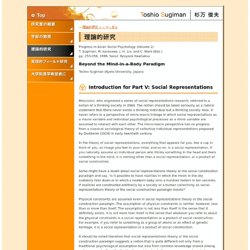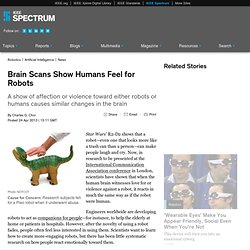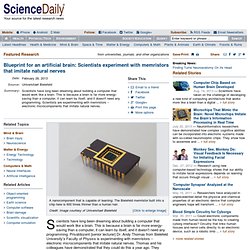

BBC - h2g2 - The Vingean Singularity - A569522. Google futurist claims we will be uploading our entire MINDS to computers by 2045 and our bodies will be replaced by machines within 90 years. Ray Kurzweil, director of engineering at Google, believes we will be able to upload our entire brains to computers within the next 32 years - an event known as singularityOur 'fragile' human body parts will be replaced by machines by the turn of the century And if these predictions comes true, it could make humans immortal By Victoria Woollaston Published: 14:22 GMT, 19 June 2013 | Updated: 14:22 GMT, 19 June 2013.

Printing tiny batteries. A research team from Harvard University and the University of Illinois at Urbana-Champaign has demonstrated the ability to 3D print a battery.

This image shows the interlaced stack of electrodes that were printed layer by layer to create the working anode and cathode of a microbattery. (SEM image courtesy of Jennifer A. Lewis.) Cambridge, Mass. – June 18, 2013 – 3D printing can now be used to print lithium-ion microbatteries the size of a grain of sand. The printed microbatteries could supply electricity to tiny devices in fields from medicine to communications, including many that have lingered on lab benches for lack of a battery small enough to fit the device, yet provide enough stored energy to power them. Vote Stalkers: Obama, Romney Campaigns Mine Trove of Voters' Online Data to Win '12 Election. Harvey Fineberg: Are we ready for neo-evolution? Future Army Robot Warrior. PETMAN. Petman Tests Camo. 6 Hours Tutorial Professor Umpleby delivered at WMSCI 2006 - DVD1 Part1. 杉万俊夫 Toshio Sugiman|理論的研究|Beyond the Mind-in-a-Body Paradigm.
Progress in Asian Social Psychology (Volume 2) T.

Sugiman, M. karasawa, J. H. The Transition Between Human And Cyborg. Lepht Anonym - Cybernetics for the Masses (1 of 3) The most realistic female android ever! Do Kids Care If Their Robot Friend Gets Stuffed Into a Closet? "Please don't put me in the closet," cries the robot.

Last week, we wrote about a study that looked at whether humans attribute moral accountability and emotions to robots. This week, we've got a study from the same group, the Human Interaction With Nature and Technological Systems Lab (HINTS) at the University of Washington, that takes a look at what kind of relationships children are likely to form with social robot platforms, and it involves forcing their new robot friend into a dark, lonely closet. The 90 children in this study were separated into three groups by age: 9 year olds, 12 year olds, and 15 year olds, with an equal mix of boys and girls. Meet Nao: The first robot able to develop emotions and form a bond with humans. By Daily Mail Reporter Updated: 11:52 GMT, 13 August 2010.

Humans Show Empathy for Robots. From R2-D2 in "Star Wars" to Furby, robots can generate surprisingly humanlike feelings.

Watching a robot being abused or cuddled has a similar effect on people to seeing those things done to a human, new research shows. Humans are increasingly exposed to robots in their daily lives, but little is known about how these lifelike machines influence human emotions. Feeling bad for bots In two new studies, researchers sought to measure how people responded to robots on an emotional and neurological level. Brain Scans Show Humans Feel for Robots. Star Wars’ R2-D2 shows that a robot—even one that looks more like a trash can than a person—can make people laugh and cry.

Now, in research to be presented at the International Communication Association conference in London, scientists have shown that when the human brain witnesses love for or violence against a robot, it reacts in much the same way as if the robot were human. Engineers worldwide are developing robots to act as companions for people—for instance, to help the elderly at home or patients in hospitals. How Team Obama’s tech efficiency left Romney IT in dust. Despite running a campaign with about twice the money and twice the staff of Governor Mitt Romney's presidential bid, President Barack Obama's campaign under-spent Romney's on IT products and services by $14.5 million, putting the money instead into building an internal tech team.

Based on an Ars analysis of Federal Election Commission filings, the Obama campaign, all-inclusive, spent $9.3 million on technology services and consulting and under $2 million on internal technology-related payroll. The bottom line is that the Obama campaign's emphasis on people over capital and use of open-source tools to develop and operate its sophisticated cloud-based infrastructure ended up actually saving the campaign money. As Scott VanDenPlas, lead DevOps for Obama for America put it in an e-mail interview with Ars, "A lesson which we took to heart from 2008 [was that] operational efficiency is an enormous strategic advantage. " Smart, not perfect. Hod Lipson builds "self-aware" robots. Wang Zi Won. Ghost In The Shell - A robot's theory on god. The Robot Buddha. Rat Brain Robot. Rats mind-reading technology: Scientists create 'telepathic' connection.
Blueprint for an artificial brain: Scientists experiment with memristors that imitate natural nerves. Scientists have long been dreaming about building a computer that would work like a brain.

This is because a brain is far more energy-saving than a computer, it can learn by itself, and it doesn't need any programming. Creating indestructible self-healing circuits. Imagine that the chips in your smart phone or computer could repair and defend themselves on the fly, recovering in microseconds from problems ranging from less-than-ideal battery power to total transistor failure.

It might sound like the stuff of science fiction, but a team of engineers at the California Institute of Technology (Caltech), for the first time ever, has developed just such self-healing integrated chips. The team, made up of members of the High-Speed Integrated Circuits laboratory in Caltech's Division of Engineering and Applied Science, has demonstrated this self-healing capability in tiny power amplifiers. The amplifiers are so small, in fact, that 76 of the chips -- including everything they need to self-heal -- could fit on a single penny.
"It was incredible the first time the system kicked in and healed itself. It felt like we were witnessing the next step in the evolution of integrated circuits," says Ali Hajimiri, the Thomas G. USC: Restoring Memory, Repairing Damaged Brains. Biomedical engineers analyze—and duplicate—the neural mechanism of learning in rats LOS ANGELES , June 17, 2011 /PRNewswire-USNewswire/ -- Scientists have developed a way to turn memories on and off—literally with the flip of a switch. Researchers Replace Passwords With Mind-Reading Passthoughts. Remembering the passwords for all your sites can get frustrating. There are only so many punctuation, number substitutes and uppercase variations you can recall, and writing them down for all to find is hardly an option. Thanks to researchers at the UC Berkeley School of Information, you may not need to type those pesky passwords in the future. Instead, you'll only need to think them. By measuring brainwaves with biosensor technology, researchers are able to replace passwords with "passthoughts" for computer authentication.
A $100 headset wirelessly connects to a computer via Bluetooth, and the device's sensor rests against the user’s forehead, providing a electroencephalogram (EEG) signal from the brain. Remote Control of Brain Activity Using Ultrasound Dr. William J. Tyler is an Assistant Professor in the School of Life Sciences at Arizona State University, is a co-founder and the CSO of SynSonix, Inc., and a member of the 2010 DARPA Young Faculty Award class. Every single aspect of human sensation, perception, emotion, and behavior is regulated by brain activity. Thus, having the ability to stimulate brain function is a powerful technology. Recent advances in neurotechnology have shown that brain stimulation is capable of treating neurological diseases and brain injury, as well as serving platforms around which brain-computer interfaces can be built for various purposes. Scientists Read Dreams. By Mo Costandi of Nature magazine Scientists have learned how to discover what you are dreaming about while you sleep.
A team of researchers led by Yukiyasu Kamitani of the ATR Computational Neuroscience Laboratories in Kyoto, Japan, used functional neuroimaging to scan the brains of three people as they slept, simultaneously recording their brain waves using electroencephalography (EEG). The researchers woke the participants whenever they detected the pattern of brain waves associated with sleep onset, asked them what they had just dreamed about, and then asked them to go back to sleep.
This was done in three-hour blocks, and repeated between seven and ten times, on different days, for each participant. During each block, participants were woken up ten times per hour. Drugs, Body Modifications May Create Second Enlightenment. Man sees with 'bionic eye' Double Amputee Transformed Into Mermaid With Help From Prosthetics.
PW Singer on military robots and the future of war. Cool New Autonomous Robot - The Beginning of Skynet? BigDog Overview (Updated March 2010) Military Researchers Develop Corpse-Eating Robots. Bionic Soldiers. New robotic hand 'can feel' Mind-Reading Experiment Reconstructs Movies in Our Mind. The approximate reconstruction (right) of a movie clip (left) is achieved through brain imaging and computer simulation.UC Berkeley It sounds like science fiction: While volunteers watched movie clips, a scanner watched their brains. And from their brain activity, a computer made rough reconstructions of what they viewed. On the Feasibility of Side-Channel Attacks with Brain-Computer Interfaces. Brain computer interfaces (BCI) are becoming increasingly popular in the gaming and entertainment industries.
How to Build a Device that Improves Our Neural Abilities. First mind-reading implant gives rats telepathic power - life - 28 February 2013. Read full article. Automaton. IBM’s Watson Tries to Learn…Everything. Love Robot Holds Female Lab Intern Prisoner. The Truth About Kenji, the Robot Programmed to Love. Leaders Of The 3D Printing Revolution.